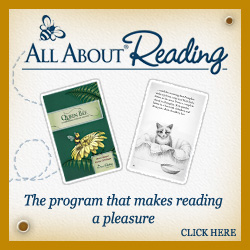We just finished All About Reading Level 2!
We love this program! I especially like that reading and spelling are done separately since most students will be able to read words that they are not yet ready to spell. So, now that we have completed AAR Level 2, we will now start All About Spelling Level 2.
Through some trial and error, I have come up with a system that works to help us continue to review and solidify the reading concepts she's already learned while also working through the new spelling lessons. This review ensures that Miss A. is working on reading and spelling every day and keeping them fresh in her mind.
Review. Read through 10 word cards and/or phonogram cards still located behind our review dividers. We do this very quickly - 1 to 2 minutes max.
Challenge Words. Work through the challenge words on the fluency pages. These were words that we skipped when working through the curriculum. I go back through the fluency pages, find all the pages with challenge words and assemble them together on a clipboard. Each day Miss A. will read through a section for about 10 minutes.
Re-read Stories. Practice re-reading through the provided readers (What is This? and Queen Bee), one story per day. This is something that we do at bedtime. She reads one story to me, and then I read to her from a selected re-aloud. Snuggling makes it so much more enjoyable!
 |
| We love the stories in these readers! |
New Material. Read outside material/books at other times throughout the day. This is the difficult one!
The All About Learning curriculum is by far the best I've encountered in our homeschooling journey. I sincerely mean that to include all curriculum we've tried, not just curriculum for language arts! But, if I HAD to list one complaint it would be finding readers and books that correspond to the curriculum. Since the curriculum follows a somewhat non-traditional method of teaching phonics with very few sight words, the result is that children get a solid understanding of phonics but also are not able to read much on their own besides the readers provided.
This would not have been an issue for me (because we love the stories in the readers and don't mind re-reading them), but Miss A. was lacking confidence in her ability to read on her own. She almost didn't even believe me that she could read because she thought the only books she could read were the AAR readers.
My mission became finding books and readers she could read mostly, if not all, by herself. I also didn't want to tell her to read a book (since I was also requiring her to read to me at bedtime); I want to inspire her to read it on her own.
This is what has worked for me. First, I chose a book. I could not find any books that corresponded exactly to the curriculum, but I found that if I chose books that were familiar (we've read together before or even multiple times) and used a lot of rhyming, we had success.
Next, I sat down with her and we read through it together. When we encountered an unfamiliar word which contained a phonogram that hadn't been learned, I simply read the word for her and quickly kept going. The object is to create confidence, NOT teach new phonograms. Of course, if they are interested in learning, go ahead.
After sitting down with Miss A. and going through a few books in this way, she was able to read the following books on her own (and enjoyed doing it). Hopefully I will be able to add to this list and help others who find themselves in a similar situation. These are all Dr. Seuss books (like I said, lots of rhyming!).
- One Fish, Two Fish, Red Fish, Blue Fish
- Green Eggs and Ham
- Hop on Pop
If you encounter any other books that your child can read after AAR Level 2, please let me know in the comments!

















